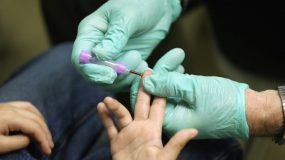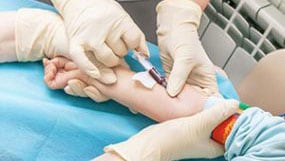Recommended Actions Based on Blood Lead Level
Summary of Recommendations for Follow-up and Case Management for Children
CDC recommends testing blood for lead exposure. Two types of blood collection tests may be used:

Capillary sample: A finger-prick or heel-prick is used to take a small amount of blood to test for lead.

Venous sample: A small amount of blood is taken after a needle is inserted into the patient’s vein to test for lead.
A patient’s blood lead level (BLL) is measured in micrograms of lead per deciliter of blood (μg/dL). Recommendations are provided for initial screening capillary and confirmed* venous BLLs.
Initial Screening Blood Lead Level
Healthcare providers may use a capillary or venous sample for initial BLL screening. If the capillary results are equal to or greater than CDC’s Blood Lead Reference Value (BLRV), providers should collect a venous sample. If a venous sample was taken during the initial screening test, skip to Confirmed Venous Blood Lead Level.
Confirmed Venous Blood Lead Level
CDC recommends that healthcare providers use a venous draw for confirmatory BLL screening. If the initial screening test used a venous sample, the patient does not need another venous draw.
Table 1: Recommended Schedule for Obtaining a Confirmatory Venous Sample
| Blood Lead Level (μg/dL) | Time to Confirmation Testing** |
| ≥3.5–9 | Within 3 months |
| 10–19 | Within 1 month |
| 20–44 | Within 2 weeks |
| ≥45 | Within 48 hours |
**The higher the BLL is on the initial screening capillary test, the more urgent it is to get a venous sample for confirmatory testing.
Table 2: Schedule for Follow-Up Blood Lead Testinga
| Venous blood lead levels (µg/dL) | Early follow up testing (2–4 tests after initial test above specific venous BLLs) | Later follow up testing after BLL declining |
| ≥3.5–9 | 3 months* | 6–9 months |
| 10–19 | 1–3 months* | 3–6 months |
| 20–44 | 2 weeks–1 month | 1–3 months |
| ≥45 | As soon as possible | As soon as possible |
a Changes in BLLs due to seasonal weather changes may be more apparent in colder climate areas. Greater exposure in the summer months may necessitate more frequent follow ups.
*Some case managers or healthcare providers may choose to repeat blood lead tests on all new patients within a month. Repeated testing may confirm that the child’s BLL is decreasing.
References
- Pediatric Environmental Health Specialty Units. Recommendations on Management of Childhood Lead Exposure: A Resource for Clinicians. [PDF – 232] Last Updated Sep 2021. Accessed 15 Oct 2021.
- American Academy of Pediatrics Council on Environmental Health. Chapter 32: Lead. In: Etzel RA, ed. Pediatric Environmental Health, 4thEdition; Itasca, IL: American Academy of Pediatrics; 2019:557–584.
- Hauptman M, Bruccoleri R, Woolf AD. An Update on Childhood Lead Poisoning. Clinical Pediatric Emergency Medicine. 2017 September; 18(3): 181–192.
- Advisory Committee for Childhood Lead Poisoning Prevention, 2012. Low Level Lead Exposure Harms Children: A Renewed Call for Primary Prevention [PDF – 922 KB]
- The Clinical & Laboratory Standards Institute (CLSI) Guidelines #C40: Measurement Procedures for the Determination of Lead Concentrations in Blood and Urine, 2nd Edition (October 2013).
Additional Resources
- Blood Lead Levels in Children – information on blood lead testing in children
- Fact Sheet: Blood Lead Levels in Children [PDF – 100 KB] – fact sheet with information on blood lead levels in children.
- CDC’s Recommended Terminology When Discussing Children’s Blood Lead Levels [PDF – 330 KB] – guidance for interpreting and discussing children’s blood lead levels.
- Testing Children for Lead Poisoning – information about testing children for lead poisoning.
- Blood Lead Reference Value – CDC recommendations on children’s blood lead levels.
- American Academy of Pediatrics (AAP) information on lead exposure – information and resources for physicians on prevention and medical management.
- Find a Pediatric Environmental Health Specialty Unit (PEHSU) in Your Region – information about protecting children from environmental hazards.
- Learn more about the causes, symptoms, and prevention of childhood lead exposure with these videos in English and en Español.